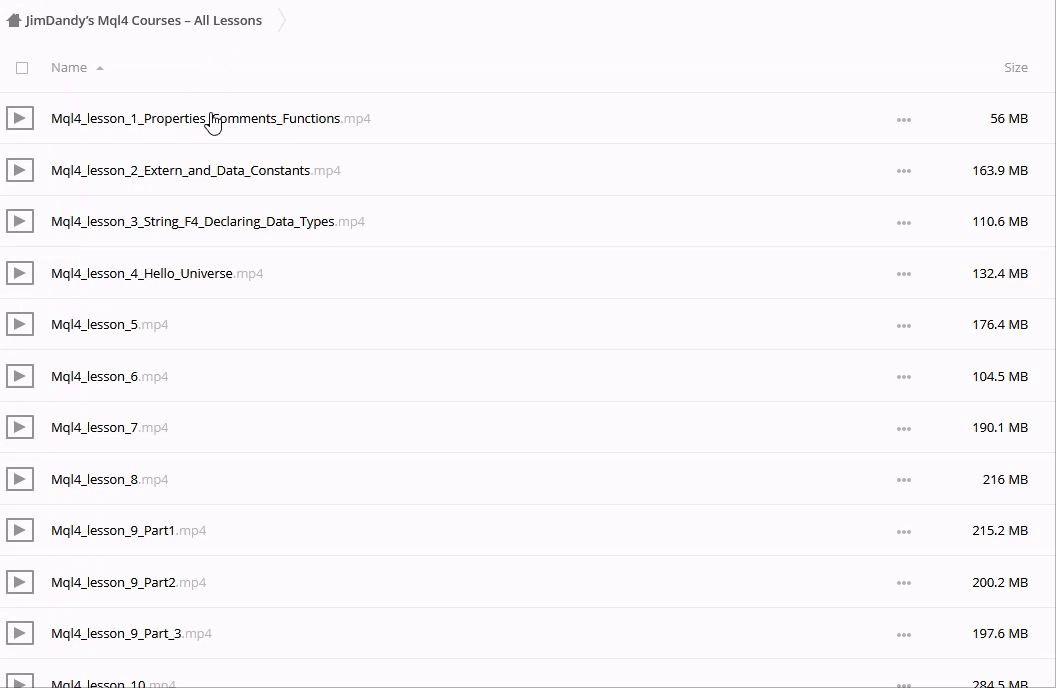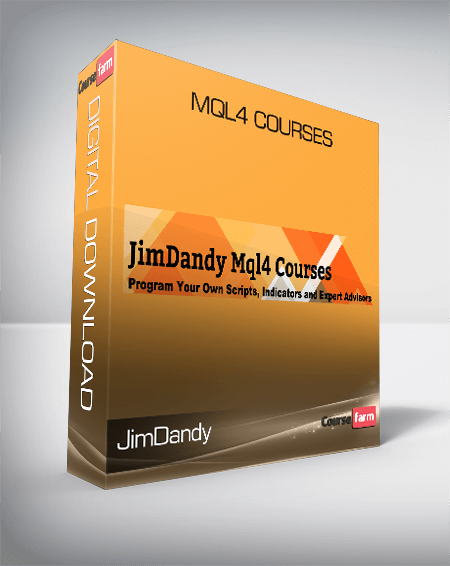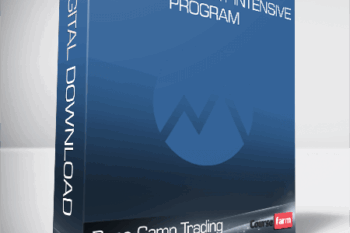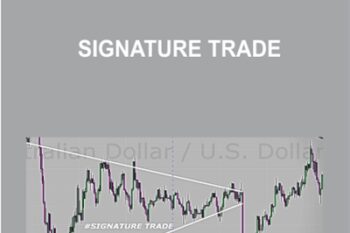Achieve more with the JimDandy – Mql4 Courses course, priced at just Original price was: $247.00.$52.00Current price is: $52.00. on GBESY.biz! Explore our extensive collection of over 60,000 downloadable courses in Forex and Trading. We offer professional, self-paced digital education at up to 80% off original rates. Start transforming your expertise now!
We join Groupbuy AND always try to share knowledge with more people. Especially the quality is the same as salepage. You can buy directly at salepage, with full price. (link SALEPAGE are mounted directly on the post)
JimDandy – Mql4 Courses

Module 1
| Module 1 | The Basics |
| Unit 1 | A Look Around the “New” MetaEditor |
| Unit 2 | Precompiler Lines and the FrameWork of Our Code |
| Module 2 | 610 Functions Explained and the Debugger |
| Unit 1 | How a Function is Written |
| Unit 2 | Calling a Function |
| Unit 3 | Debugger |
| Module 3 | 610 Variables and Data Types |
| Unit 1 | Variables and Data Types |
| Unit 2 | Integers, Bytes, Bits? How a Computer Stores Numbers |
| Unit 3 | Keeping Time With DateTime and OnTimer() |
| Unit 4 | Working With the Color Integer Data Type |
| Unit 5 | Creating Our Own Integer Data Types with Enumerations |
| Unit 6 | Boolean Type Integers |
| Unit 7 | Floats,Doubles and Strings |
| Unit 8 | Global Scope, Local Scope and Static Variables |
| Unit 9 | Extern or Input? |
| Module 4 | Operations |
| Unit 1 | Arithmetic Operations |
| Unit 2 | Assignment Operations |
| Unit 3 | Relation Operations |
| Unit 4 | Boolean Operations |
| Unit 5 | Ternary Operator |
| Unit 6 | Switch Operator |
| Unit 7 | While and Do While Loop Operators |
| Unit 8 | For Loop Operator |
| Module 5 | Object Oriented Programming Basics: Structures and Classes. |
| Unit 1 | Structures |
| Unit 2 | Structures…Classes…Necessary? |
| Unit 3 | Constructors |
| Unit 4 | Destructors |
| Unit 5 | Classes, Setters and Getters |
| Unit 6 | Encapsulation, Extensibility, Overloading, PolyMorphism? |
| Unit 7 | Using the Mql4 Wizard to Create a Class |
| Unit 8 | Inheritance |
| Unit 9 | OOP Conclusion and Commentary |
Module 2
| Module 1 | So What’s a Script and How Do We Make One? |
| Unit 1 | What is a Script? |
| Unit 2 | Daily Range Script |
| Module 2 | MessageBox A Useful Tool |
| Unit 1 | Introduction to MessageBox |
| Unit 2 | Message Box Flags |
| Unit 3 | #Defines and the Hexadecimal System |
| Unit 4 | Using MessageBox to Choose Our Path |
| Module 3 | Getting Our Attention with Email and Push Notifications |
| Unit 1 | Sounding an Alert |
| Unit 2 | Email and Push Notifications |
| Module 4 | Knowledge Is Power (Gathering Information) |
| Unit 1 | Gathering Information Using Pre Defined Variables. |
| Unit 2 | MarketInfo() Function Part1 |
| Unit 3 | MarketInfoFunction() Part2 |
| Unit 4 | AccountInfo |
| Module 5 | Order Management Using Scripts |
| Unit 1 | Sending Orders With Scripts |
| Unit 2 | Selecting an Order For Modification |
| Unit 3 | Error Checking in Our Code |
| Unit 4 | Placing Pending Orders |
| Unit 5 | Buying/Selling Scripts and Point/Pip Explained. |
| Unit 6 | Drag And Drop Scripts |
| Unit 7 | Deleting Pending Orders |
| Unit 8 | Using a For Loop to Delete Orders |
| Unit 9 | Closing Market Orders (Trades) |
Module 3
| Module 1 | Indicators And The Arrays That Make Them Possible |
| Unit 1 | Custom Indicator Introduction |
| Unit 2 | The Simplest Indicator and Where It Comes From |
| Unit 3 | Series Arrays |
| Unit 4 | Array Functions Explained |
| Module 2 | How To Write the Code For an Indicator |
| Unit 1 | How Indicators Become Part of the Chart. |
| Unit 2 | Making the Indicator Display at a Specific Place On the Chart. |
| Unit 3 | The New OnCalculate Function |
| Unit 4 | Drawing With Loops and Array Out of Range |
| Unit 5 | Putting Logic Into Our Indicator |
| Module 3 | Moving our Indicator to a Separate Window |
| Unit 1 | Putting An Indicator in a Separate Window |
| Unit 2 | Setting Properties During OnInit Instead of Using Pre-Compiler Lines. |
| Module 4 | Working With Technical Indicators |
| Unit 1 | Technical Indicators Save A Lot of Coding |
| Unit 2 | Let’s Make an MA |
| Unit 3 | Setting up MaCross Graphics |
| Unit 4 | Setting Up MaCross Logic |
| Module 5 | Putting Controls in Our Indicators |
| Unit 1 | Putting Settings In Our MA Cross Signal |
| Unit 2 | Bollinger Band Signals |
| Unit 3 | Fixing Array Out of Range Part 1 |
| Unit 4 | Fixing Array Out of Range Part 2 |
| Unit 5 | Putting in the Notifications |
| Module 6 | Combining Indicators into One Signal |
| Unit 1 | Bollinger Stochastic Combo Part 1 |
| Unit 2 | Bollinger Stochastic Combo Part 2 |
| Module 7 | How To Call a Custom Indicator |
| Unit 1 | Calling Custom Indicators Part 1 |
| Unit 2 | Calling Custom Indicators Part 2 |
| Unit 3 | Calling Custom Indicators Part 3 |
| Module 8 | Special Multi-Colored Full Adjustable Macd Indicator |
| Unit 1 | Our Oscillator Part 1 |
| Unit 2 | Our Oscillator Part 2 |
| Unit 3 | Our Oscillator Part 3 |
| Unit 4 | Our Oscillator Part 4 |
Module 4
| Module 1 | Making it Idiot Proof and Controlling Access |
| Unit 1 | Starting From the Beginning |
| Unit 2 | Checking Our Settings |
| Unit 3 | Password Protection |
| Unit 4 | Your Expert Can Close Itself! |
| Unit 5 | Code that will expire. |
| Module 2 | The Basic Foundation |
| Unit 1 | The Mandatory Components of a Basic EA |
| Unit 2 | Reviewing The Basic Components |
| Module 3 | Using iCustom To Call Your Indicator |
| Unit 1 | How to Call a Custom Indicator With iCustom() |
| Unit 2 | Calling With Custom Parameters |
| Unit 3 | Multiple TimeFrame Problems |
| Unit 4 | Custom Indicator Calling Tool and DEMA EA |
| Unit 5 | Practice Your Trigger Coding |
| Module 4 | Adding More Functionality to Our Basic EA |
| Unit 1 | Auto-Generating Our MagicNumbers |
| Unit 2 | Adding Move to BreakEven |
| Unit 3 | Adding a Trailing Stop |
| Unit 4 | Adding a Candle (Swing High/Low) Stop |
| Unit 5 | Solving Stoploss Coding Problems |
| Unit 6 | Moving Indicator Code Into Our Expert Advisor |
| Module 5 | Controlling the Opening and Closing Of Trades |
| Unit 1 | Limiting Number of Orders and Checking if Hedging is Allowed |
| Unit 2 | Closing On Opposite Signal |
| Unit 3 | Closing Trades On a FIFO Compliant Platform |
| Module 6 | Martingaling The Two-Edged Sword |
| Unit 1 | Martingaling |
| Unit 2 | Market Trapper Part 1 |
| Unit 3 | Market Trapper Part2 |
| Module 7 | Controlling a Sequence of Trades |
| Unit 1 | Using Trade Comments to Identify Trades |
| Unit 2 | Knowing When to Quit Trading |
| Unit 3 | An OnScreen Display to Monitor Our Situation |
| Unit 4 | Setting Lotsize For Each Trade in The Sequence. |
| Module 8 | Basket Trading |
| Unit 1 | Introducing Basket Trading |
| Unit 2 | Coding a MACD Trigger |
| Unit 3 | Controlling our Trade Spacing |
| Unit 4 | The Math of “Cost Averaging” |
| Unit 5 | Closing All Trades Together |
| Unit 6 | Using a Auto-Mild Martingale |
| Unit 7 | Manual Martingale |
| Unit 8 | BasketTrader Smartingale |
| Unit 9 | Displaying the Basket Breakeven |
| Unit 10 | Basket Trader Finished. |
| Unit 11 | Concluding Remarks |
Below is Proof content:

Invest in endless knowledge with the JimDandy – Mql4 Courses course at GBESY.biz! Gain lifetime access to premium digital content designed to fuel your professional and personal growth.
- Lifetime Access: Unrestricted, permanent access to your purchased courses.
- Unbeatable Value: Save significantly with prices up to 80% less than direct purchases.
- Protected Payments: Complete your transactions securely.
- Empowering Skills: Learn practical, in-demand skills for immediate application.
- Immediate Download: Access your course content instantly after purchase.
- Any Device, Anywhere: Study on your preferred device with full flexibility.
Discover your next opportunity with GBESY.biz!
![GBesy [GB] GBesy [GB]](https://gbesy.biz/wp-content/uploads/2023/05/gbesy-Logo-full-100.png)
![GBesy [GB] GBesy [GB]](https://www.gbesy.com/wp-content/uploads/2023/05/gbesy-Logo-full-100.png)



 Purchase this course you will earn
Purchase this course you will earn 




